Paper crafts calm your nerves while creating through a combination of tactile sensations and mindful focus. As you handle different textures and engage in repetitive motions, your mind shifts away from stressors, promoting relaxation. The creative process stimulates dopamine release, enhancing your mood and reducing anxiety. Color choices in your crafts can also influence your emotions, with cool tones fostering calmness. Completing a project boosts your sense of accomplishment and self-esteem. Additionally, paper crafting often leads to social connections, whether online or in-person, providing further emotional support. Discover how each aspect of paper crafting contributes to your mental well-being.
Tactile Sensations and Stress Relief
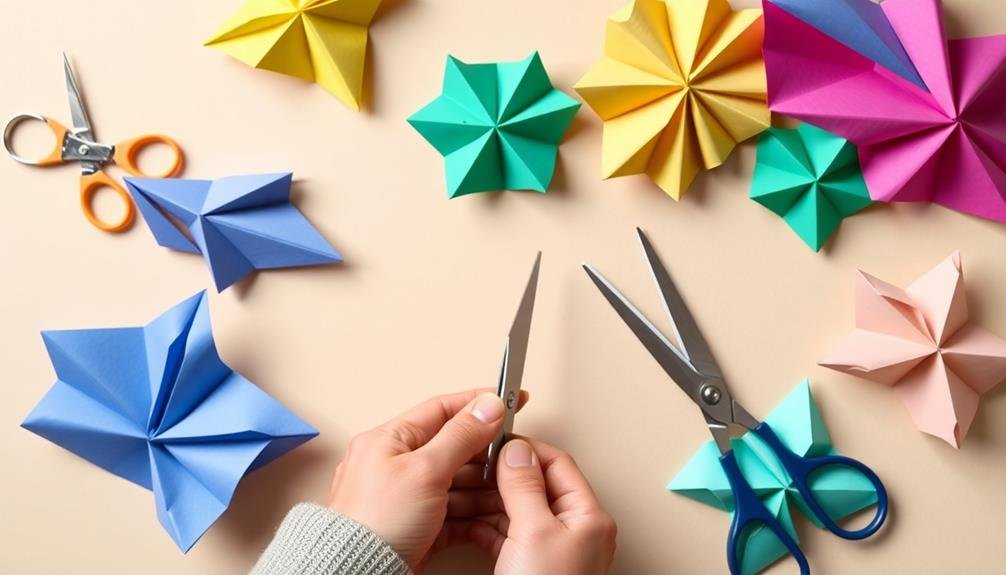
Touch is a powerful stress reliever. When you engage in paper crafts, you're actively stimulating your sense of touch, which can have a calming effect on your nervous system. As you fold, cut, and manipulate paper, you're creating a tactile experience that grounds you in the present moment.
The texture of paper against your fingertips provides sensory feedback that can be soothing and distracting from stressful thoughts. Whether you're working with smooth cardstock, textured handmade paper, or delicate tissue paper, each surface offers a unique tactile sensation that engages your brain in a different way.
As you focus on the physical act of crafting, you're naturally practicing mindfulness. This heightened awareness of your hands and the materials you're working with can help reduce anxiety and promote relaxation.
The repetitive motions involved in many paper crafts, such as folding origami or quilling, can induce a meditative state, further enhancing the stress-relieving benefits.
Mindfulness Through Paper Manipulation
As you fold, cut, and shape paper, you're naturally drawn into the present moment, focusing intently on each crease and curve.
Your hands engage with the tactile sensations of different paper textures, connecting you to the physical world around you.
The rhythmic, repetitive motions of paper crafting can lull you into a meditative state, allowing your mind to settle and find calm.
Present-Moment Focus
Paper crafting offers a unique opportunity to practice mindfulness. As you engage in the tactile process of folding, cutting, or shaping paper, you're naturally drawn into the present moment. Your focus narrows to the task at hand, pushing aside worries about the past or future.
When you're working with paper, you're forced to pay attention to details. You'll notice the texture of the paper, the precision of your folds, and the way colors blend together. This heightened awareness of your immediate surroundings helps anchor you in the here and now.
The repetitive nature of many paper crafts, such as origami or quilling, can create a meditative state. As you repeat the same actions, your mind settles into a rhythm, promoting a sense of calm and centeredness. You'll find that intrusive thoughts fade away as you concentrate on each step of your project.
Moreover, paper crafting often requires problem-solving skills. When you encounter challenges, you're compelled to focus on finding solutions in real-time, further reinforcing your connection to the present moment.
Tactile Sensory Engagement
Sensory exploration lies at the heart of paper crafting's relaxation benefits. As you engage with paper, your fingertips become attuned to its texture, weight, and temperature. You'll notice the subtle differences between smooth cardstock and textured handmade paper, each offering a unique tactile experience. This mindful touch activates your sensory neurons, grounding you in the present moment and diverting your attention from stressors.
When you fold, crease, or cut paper, you're not just creating art—you're stimulating your sense of touch. The act of manipulating paper engages your proprioception, the awareness of your body's position in space. This physical interaction can be deeply soothing, much like the calming effect of kneading dough or molding clay.
The variety of paper textures available adds another layer to this sensory experience. From delicate tissue paper to sturdy corrugated cardboard, each material offers a different tactile sensation. As you work, you'll find yourself becoming more aware of these subtle differences, enhancing your overall sensory engagement and deepening your connection to the craft.
Rhythmic Repetitive Motions
While many aspects of paper crafting contribute to its calming effects, the rhythmic, repetitive motions involved play a crucial role in fostering mindfulness. As you fold, cut, or crease paper, you'll find yourself engaging in a series of consistent movements that can lull your mind into a meditative state.
These repetitive actions help you focus on the present moment, drawing your attention away from worries and stressors. You'll notice your breathing naturally slowing down as you fall into a rhythm, further enhancing the relaxation effect. The predictability of these motions also provides a sense of control and accomplishment, boosting your mood and self-esteem.
Different paper crafts offer various rhythmic motions:
| Craft Type | Repetitive Motion | Benefit |
|---|---|---|
| Origami | Precise folding | Improves concentration |
| Quilling | Paper rolling | Enhances fine motor skills |
| Paper cutting | Steady scissor work | Builds patience and focus |
Creative Focus and Anxiety Reduction
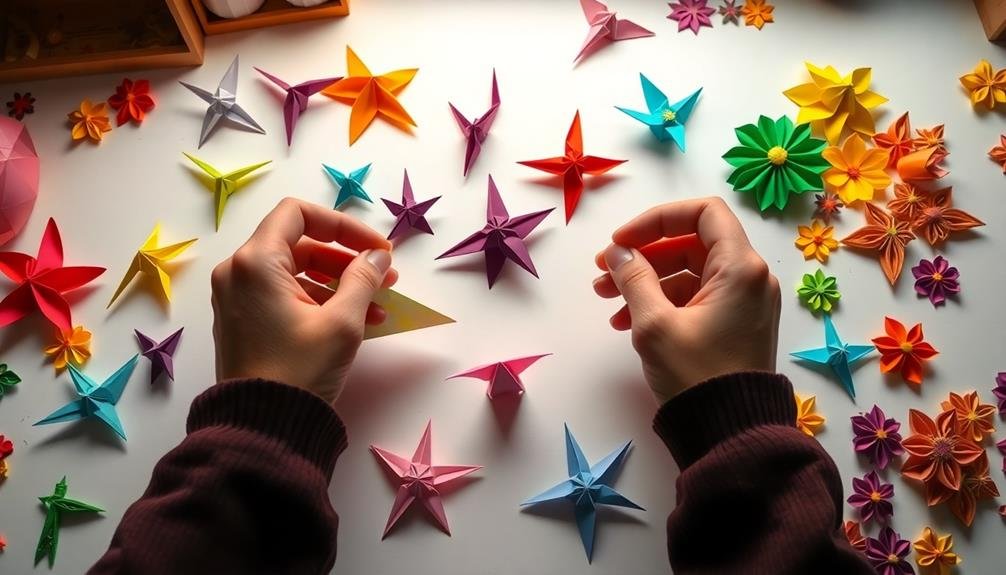
Engaging in paper crafts can sharpen your creative focus and considerably reduce anxiety. When you immerse yourself in a paper project, you're forced to concentrate on the task at hand, pushing aside intrusive thoughts and worries. This intense focus acts as a form of mindfulness, anchoring you in the present moment.
As you work with paper, your mind enters a state of flow, where time seems to slip away and your awareness narrows to the creative process. This mental state can be deeply calming and therapeutic, offering a respite from the constant chatter of an anxious mind. You'll find that your breathing naturally slows and your muscles relax as you become absorbed in your craft.
Paper crafts also provide a sense of control and accomplishment. As you transform simple sheets into intricate designs, you're creating tangible proof of your abilities. This boost in self-efficacy can help combat feelings of helplessness often associated with anxiety.
Furthermore, the act of creation itself stimulates the release of dopamine, the brain's "feel-good" neurotransmitter, further enhancing your mood and reducing stress levels.
Color Therapy in Paper Crafts
Color therapy in paper crafts offers a powerful avenue for emotional expression and healing. As you work with different hues and shades, you're tapping into the psychological effects of color on your mood and emotions. Warm colors like red, orange, and yellow can energize and uplift you, while cool colors like blue, green, and purple can calm and soothe your nerves.
When you choose colors for your paper projects, you're engaging in a form of self-expression that can help you process complex emotions. Bright, vibrant colors might reflect joy or excitement, while muted tones could represent introspection or melancholy. By consciously selecting colors that resonate with your current state of mind, you're acknowledging and validating your feelings.
The act of combining different colors in your paper crafts can also be therapeutic. You'll find that creating harmonious color schemes or experimenting with contrasting hues stimulates your creativity and focuses your mind.
This process can help you achieve a sense of balance and order, reducing stress and anxiety. As you immerse yourself in the world of color through paper crafting, you'll discover a powerful tool for emotional regulation and self-discovery.
Repetitive Motions for Mental Calm
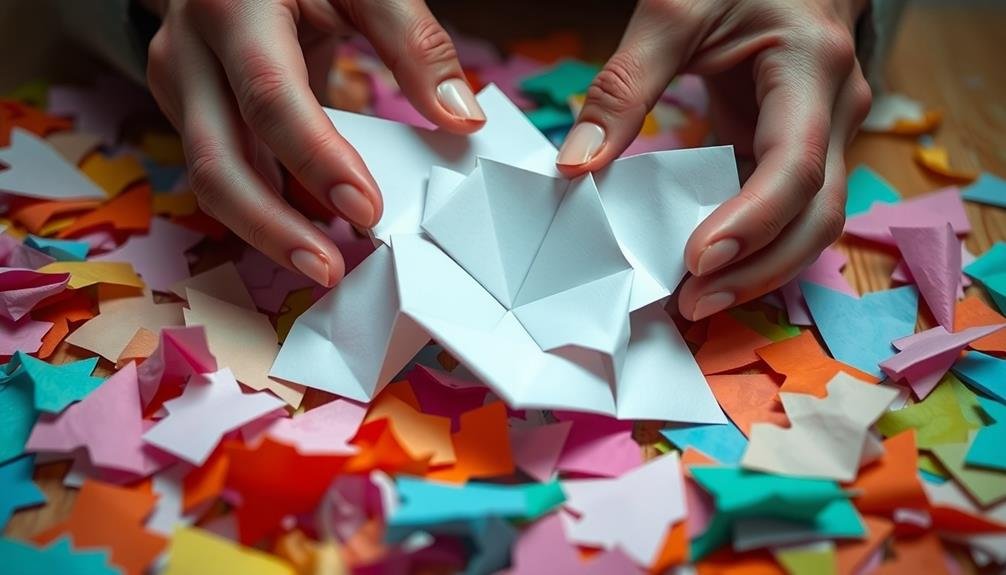
You'll find that many paper crafts involve repetitive actions that can calm your mind.
As you engage in rhythmic motions like folding, cutting, or weaving, you'll notice your anxiety melting away.
These focused movements allow you to enter a meditative state, reducing stress and promoting mental clarity.
Rhythmic Actions Soothe Anxiety
Through repetitive motions, paper crafts offer a soothing rhythm that can greatly reduce anxiety. As you fold, cut, or weave paper, your hands fall into a natural pattern that calms your mind. This rhythmic action triggers your body's relaxation response, lowering stress hormones and slowing your heart rate.
When you're anxious, your thoughts often race and jump from one worry to another. Engaging in rhythmic paper crafting forces your brain to focus on the present moment, breaking the cycle of anxious thoughts. The predictable nature of these movements provides a sense of control and stability, which can be particularly comforting during uncertain times.
You'll find that different paper crafts offer various rhythmic actions. Origami involves repetitive folding, while quilling requires rolling thin strips of paper. Even simple actions like cutting paper into strips or shapes can create a meditative state.
As you practice these techniques, you'll likely notice your breathing becoming more regulated and your muscles relaxing. This physical response reinforces the mental calm, creating a positive feedback loop that further reduces anxiety.
Focused Movements Reduce Stress
Engaging in focused, repetitive movements during paper crafting can considerably reduce stress levels. When you're folding origami, cutting intricate patterns, or methodically gluing pieces together, your mind enters a state of flow. This focused attention on precise movements helps shift your thoughts away from daily worries and anxieties.
As you repeat these actions, your brain releases neurotransmitters like dopamine and serotonin, which promote feelings of calm and well-being. You'll notice your breathing becomes more regular and your muscles start to relax. The rhythmic nature of these movements can even lower your heart rate and blood pressure.
Moreover, the tactile sensation of handling paper engages your senses, grounding you in the present moment. This mindfulness aspect of paper crafting further enhances its stress-reducing benefits.
You're not just creating art; you're giving your mind a much-needed break from the constant barrage of thoughts and stimuli.
Accomplishment and Self-Esteem Boost
A sense of accomplishment washes over you as you complete a paper craft project. This feeling isn't just momentary; it's a powerful boost to your self-esteem that can have lasting effects.
When you create something tangible with your own hands, you're proving to yourself that you're capable and creative. Each finished craft serves as a physical reminder of your skills and dedication.
Whether it's a simple origami figure or an intricate paper quilling design, you've transformed a plain sheet into a work of art. This transformation process reinforces your ability to learn, adapt, and overcome challenges.
As you accumulate completed projects, you're building a portfolio of achievements. You'll find yourself setting more ambitious goals and tackling increasingly complex designs.
This progression fuels a positive cycle of growth and confidence. You're not just folding paper; you're cultivating patience, precision, and problem-solving skills.
Moreover, sharing your creations with others can lead to recognition and praise, further reinforcing your sense of accomplishment.
You'll discover that paper crafting isn't just a hobby—it's a path to personal growth and enhanced self-worth.
Social Connections via Crafting
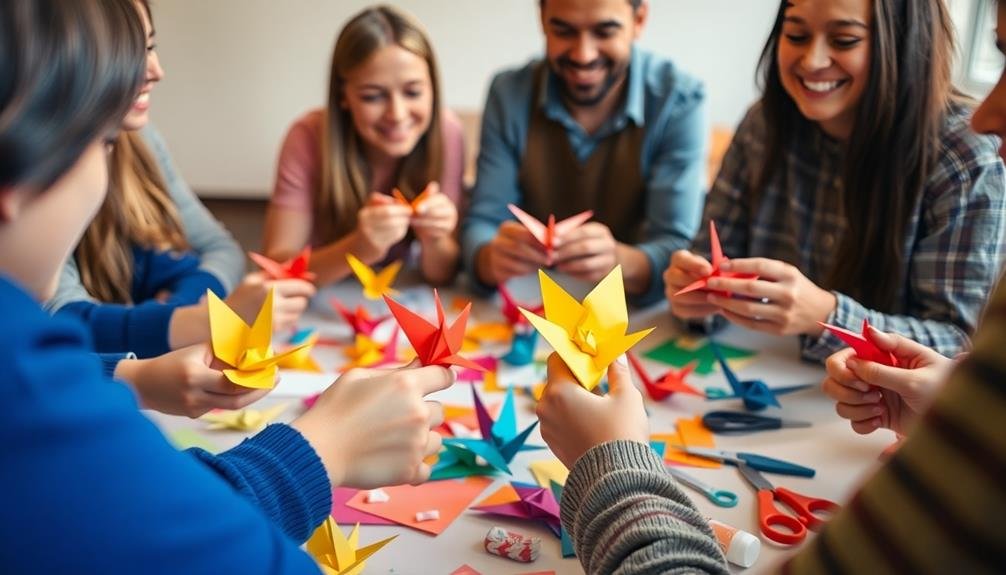
Beyond personal growth, paper crafting opens doors to vibrant social connections. You'll find numerous opportunities to engage with fellow crafters, both online and in-person.
Join local crafting groups or workshops to meet like-minded individuals who share your passion. These gatherings provide a platform to exchange ideas, learn new techniques, and showcase your creations.
Online communities offer another avenue for connection. Participate in forums, social media groups, or video-sharing platforms dedicated to paper crafts. You'll discover a wealth of inspiration, tutorials, and friendly discussions.
Don't hesitate to share your projects and offer constructive feedback to others.
Crafting events and conventions bring enthusiasts together on a larger scale. Attend these gatherings to immerse yourself in the paper crafting world, attend workshops, and network with industry professionals.
You might even find opportunities to sell your creations or collaborate on projects.
Consider volunteering your skills for community events or charity projects. This allows you to contribute positively to society while connecting with others who value creativity and giving back.
Through these social connections, you'll expand your crafting horizons and foster lasting friendships based on shared interests.
Frequently Asked Questions
Can Paper Crafting Help With Specific Mental Health Conditions Like Depression?
Yes, paper crafting can help with depression. It's a mindful activity that boosts your mood and reduces stress. You'll feel a sense of accomplishment, express creativity, and focus on the present moment, which can alleviate depressive symptoms.
Are There Age Restrictions for Engaging in Paper Crafts for Stress Relief?
There aren't any age restrictions for paper crafts as stress relief. You can enjoy this hobby at any age. It's suitable for children, adults, and seniors alike. You'll find it's a versatile and accessible activity for everyone.
How Long Should One Practice Paper Crafting to Experience Noticeable Calming Effects?
You'll likely feel calmer after just 15-20 minutes of paper crafting. However, the more you practice, the greater the benefits. Try to engage in it regularly, even for short periods, to build a consistent stress-relief habit.
What Are the Best Paper Types for Beginners in Stress-Relieving Crafts?
You'll find lightweight cardstock or origami paper ideal for starting out. They're easy to fold and manipulate. Construction paper's a good option too. As you progress, try heavier cardstock or specialty papers for more challenging projects.
Can Paper Crafting Be Combined With Other Relaxation Techniques for Enhanced Benefits?
You can definitely combine paper crafting with other relaxation techniques. Try pairing it with deep breathing, mindfulness, or listening to calming music. You'll enhance the stress-relieving benefits and create a more immersive, soothing experience for yourself.
In Summary
As you engage in paper crafts, you're not just creating art; you're nurturing your mental health. You're calming your nerves through tactile sensations, mindful focus, and repetitive motions. You're boosting your mood with color therapy and a sense of accomplishment. Whether you're folding, cutting, or gluing, you're actively reducing stress and anxiety. So next time you're feeling overwhelmed, reach for some paper and let your creativity soothe your soul.

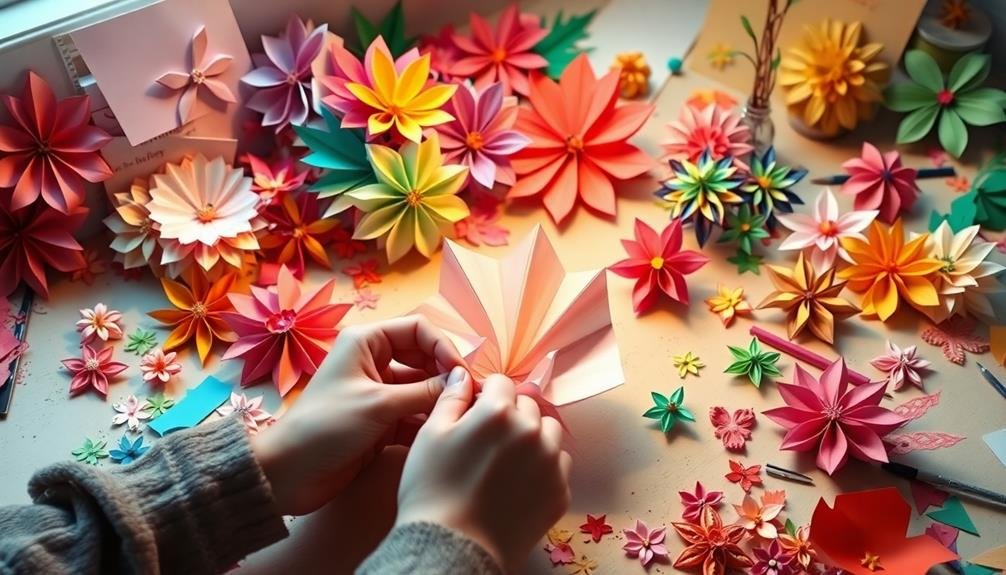



Leave a Reply